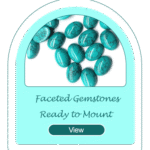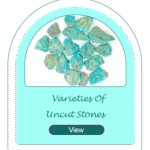Mag
8 Steps for Identifying Authentic Turquoise vs. Fake
8 Steps for Identifying Authentic Turquoise vs. Fake
Turquoise, with its mesmerizing spectrum of blues and greens, has adorned humanity for millennia. Revered by ancient civilizations and cherished by modern jewelry enthusiasts, its authenticity is paramount. Unfortunately, the high value and demand for genuine turquoise have led to a proliferation of convincing imitations, ranging from dyed stones to entirely synthetic materials.
This comprehensive guide, drawing upon established jewelers’ verification methods, outlines eight critical steps you can take to distinguish authentic, natural turquoise from its fakes, ensuring your investment is genuine.
1. Examine the Color Consistency and Hue
The color of genuine turquoise is highly variable, but it possesses a characteristic natural look that is difficult for imitations to perfectly replicate.
Natural Variation vs. Uniformity
Authentic turquoise, being a naturally occurring hydrous phosphate of copper and aluminum, rarely exhibits perfect, uniform color across the entire stone.
- Authentic Turquoise: Natural stones will show subtle variations in shade. You might see areas that lean slightly more towards sky blue, seafoam green, or even contain slight brownish undertones depending on the copper or iron content and the host rock matrix. These subtle shifts in hue are hallmarks of natural formation.
- Fake/Treated Turquoise (Especially Plastic or Glass): Imitations often have a highly uniform, almost unnaturally perfect color. If every piece in a necklace or a large cabochon displays the exact same shade with no variation, skepticism is warranted.
The Blue-Green Spectrum
The precise color is determined by trace elements:
- Copper: Tends to produce the desirable deep sky-blue color (often associated with Persian or classic American Southwest turquoise).
- Iron: Can cause the stone to lean toward greener shades.
If the color appears too vibrant, almost neon, or exhibits a glossy, painted look, it is highly suspect.
2. Inspect the Matrix (Webbing or Veining)
The matrix refers to the remnant host rock (often limonite, sandstone, or chert) that remains intertwined within the turquoise veins. This veining is one of the most reliable indicators of authenticity.
Understanding Natural Matrix Patterns
The matrix patterns are unique to each stone, much like a fingerprint.
- Spiderweb Matrix: This is the highly sought-after pattern where thin, dark lines resemble a spider’s web running throughout the blue or green stone. In natural stones, these lines follow unpredictable, organic paths.
- Chalky/Cloudy Matrix: Sometimes, the matrix is not distinct lines but rather cloudy patches of the host rock integrated into the turquoise body.
Detecting Fake Matrix
Fakers often attempt to replicate the matrix using paint, ink, or epoxy infiltration:
- Painted or Inked Matrix: Look closely at where the “webbing” meets the stone. If the dark lines appear to sit on top of the stone rather than being deeply embedded within it, it suggests artificial enhancement. The paint might chip or wear off unevenly.
- Perfectly Symmetrical Patterns: If the webbing pattern repeats identically across multiple stones in a single piece of jewelry, it is a massive red flag, as natural formations are inherently chaotic.
3. Assess the Texture and Porosity
Turquoise is naturally porous, meaning it can absorb oils, dust, and moisture over time. This porosity affects its surface texture and how it takes a polish.
Natural Texture vs. Artificial Coatings
- Natural Stone: Genuine, untreated turquoise, even when polished, retains a subtle, waxy or slightly dull finish, particularly in the unpolished areas or near the matrix lines. If it is very soft and chalky (high aluminum content), it will feel dull and potentially leave a slight residue.
- Imitations (Especially Stabilized or Reconstituted): Many modern turquoise pieces are “stabilized” (infused with resin to harden them) or “reconstituted” (crushed turquoise dust mixed with binders). While these are technically real turquoise components, they lack the natural feel. Reconstituted stones often feel unnaturally dense or uniformly glassy.
- Plastic/Glass: These materials will feel slick, overly smooth, and often slightly warm to the touch, lacking the cool, dense feeling of genuine mineral stone.
4. Perform a Hardness Test (Caution Advised)
Hardness testing is a definitive method but must be performed with extreme care, preferably only on an unfinished edge or bottom of a loose stone, as it will scratch the surface. Hardness is measured on the Mohs scale.
Mohs Scale Comparison
MaterialApproximate Mohs HardnessNotesNatural Turquoise (High Grade)5.5 – 6.5Can resist scratching from a steel nail.Natural Turquoise (Low Grade/Chalky)2 – 4Easily scratched by a steel nail.Howlite (Common Imitation)3.5Easily scratched by a knife or steel nail.Plastic (Imitation)1 – 2Extremely soft; can often be scratched by a fingernail.
The Steel Scratch Test
Using a clean, sharp steel implement (like the tip of a sturdy knife or a small steel file), apply light, firm pressure to an inconspicuous spot:
- If the material easily scrapes away leaving a soft, powdery residue, it is likely a soft imitation like dyed Howlite or plastic.
- If the steel leaves only a tiny, superficial mark or no mark at all, it suggests a harder, stabilized, or high-grade natural stone.
Note: Never attempt this test on a stone set in valuable jewelry unless you are a trained gemologist, as the risk of irreparable damage is high.
5. Look for Common Imitation Materials
Several common, inexpensive materials are frequently dyed and sold as turquoise. Identifying these substitutes is a crucial step in verification.
A. Howlite
Howlite is a naturally white or grayish mineral that is highly porous. It is easily dyed with blue or green colors and features a naturally occurring, dark, web-like matrix.
- The Tell: Dyed Howlite often has a matrix pattern that looks too stark, black, or gray against the blue. When dyed, the color saturation can appear aggressive, and the matrix lines may seem excessively dark relative to the stone’s body color.
B. Magnesite
Similar to Howlite, Magnesite is a soft, white mineral that readily accepts dye.
- The Tell: Magnesite usually results in a duller, more matte blue color compared to the vibrancy of genuine copper-colored turquoise. It is easily scratched (Mohs 3.5–4.5).
C. Plastic and Glass
These are the lowest forms of imitation, used primarily in costume jewelry.
- The Tell: Plastic often feels warm to the touch and is incredibly lightweight. Glass imitations may show signs of air bubbles trapped within the material when viewed under magnification, a feature impossible in natural mineral formation.
6. Analyze Heat Absorption and Density
Minerals behave differently than synthetic or organic materials when exposed to temperature changes.
Temperature Test
Gently hold the stone between your fingers or against your cheek for a few moments:
- Genuine Stone: Real turquoise, like most dense minerals, will absorb heat slowly and retain a distinct, cool temperature for a period after being picked up.
- Plastic/Resin: Plastic imitations will warm up almost instantly to your body temperature because they do not conduct heat efficiently.
Weight Comparison
While difficult without a control group, genuine turquoise is relatively dense.
- Genuine Stone: Feels solid and weighty for its size.
- Plastic: Will feel surprisingly light or hollow.
7. Examine the Backside and Setting
The areas of the stone that are not visible to the casual observer—the back and the edges where it meets the metal setting—can reveal much about its treatment or origin.
Unpolished Backs
- Natural Turquoise: The back of a natural cabochon is often left unpolished or features a rougher cut. You might clearly see the remnants of the host rock matrix embedded directly into the underside of the turquoise.
- Treated/Reconstituted: If the entire stone—front and back—shows a perfectly uniform color and polish, it strongly suggests that the stone has been stabilized, reconstituted, or is an entirely manufactured piece. If it’s reconstituted, the back might show a slight difference in texture or composition where the dust was bound together.
The Glue Test (for Set Stones)
If the stone is set in jewelry, examine the junction between the stone and the metal bezel.
- Warning Sign: If you see any dark, sticky residue or evidence of modern epoxy seeping out from under the stone, it suggests that a piece of stabilized material or an imitation has been glued into the setting to conceal poor fit or repair. Genuine, well-made turquoise jewelry is typically set using a tight bezel setting with minimal visible adhesive.
8. Understand Stabilization and Enhancement vs. Fakes
It is crucial to distinguish between materials that are enhanced (which are still genuine turquoise) and materials that are fake (entirely different materials substituted for turquoise).
Stabilization (Acceptable Treatment)
Most high-quality turquoise sold today is stabilized. This process involves injecting a clear resin (like Tetraethyl Orthosilicate) into the porous stone to increase its durability and colorfastness.
- Identification: Stabilized turquoise is still natural mineral, but it will feel slightly harder and less porous than raw turquoise. It should still show natural matrix patterns and variations. Stabilization is considered standard practice in the trade, but it must be disclosed by the seller.
Reconstitution (Often Misrepresented)
Reconstituted turquoise is made from pulverized turquoise scraps mixed with epoxy binders and compressed into blocks, which are then cut into stones.
- Identification: These stones lack the natural integrity of a solid vein. They might look too perfect, and the matrix lines often look unnaturally dispersed or injected.
The Rule: If the material is not mineral turquoise (i.e., it’s plastic, glass, or dyed Howlite), it is a fake. If it is turquoise but has been heavily stabilized or reconstituted, it should be priced accordingly and must be accurately disclosed.
The Importance of Sourcing from Reputable Jewelers
Verifying every aspect of a turquoise purchase can be challenging, especially for beginners. The final, and arguably most critical, step in ensuring authenticity is where you buy the stone or jewelry.
Reputable jewelers, especially those specializing in Southwestern or Native American jewelry, have established relationships with miners and lapidaries and adhere to ethical trade standards.
Why Trust Matters:
- Disclosure: Reputable dealers are obligated (and motivated) to disclose if a stone has been treated, stabilized, or reconstituted. If they claim a stone is “Natural, Untreated,” they stand behind that claim.
- Expertise: Experienced jewelers have handled thousands of genuine stones and can often identify a fake instantly based on color saturation, cut quality, or setting style that signals mass production.
- Guarantee and Return Policy: Trustworthy sources often offer guarantees of authenticity, meaning if the stone is later proven to be a non-turquoise imitation, you have recourse.
When purchasing high-value turquoise, always insist on a written guarantee of material composition, and never hesitate to ask detailed questions about the stone’s origin and any treatments it has undergone.



